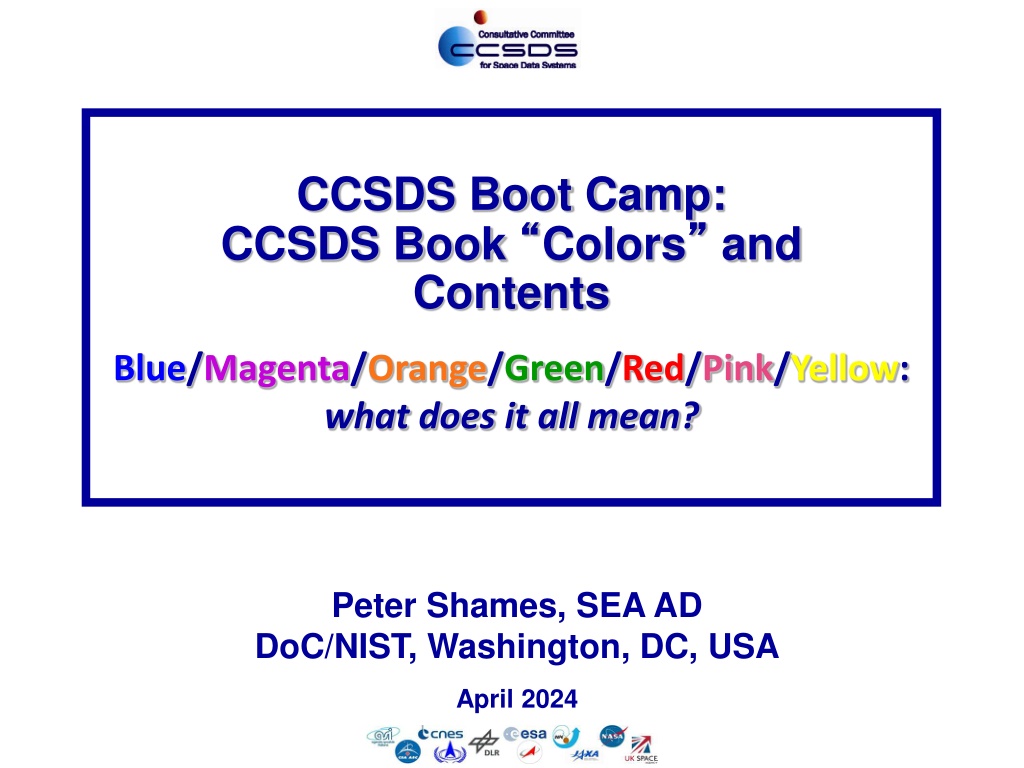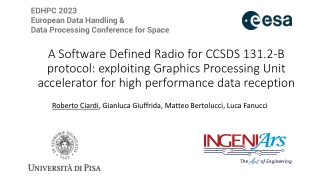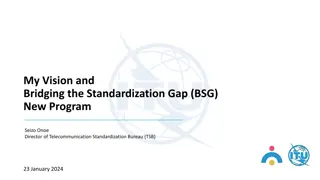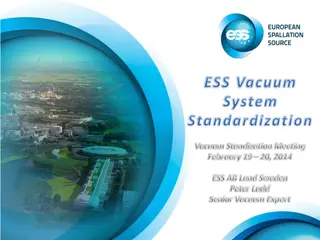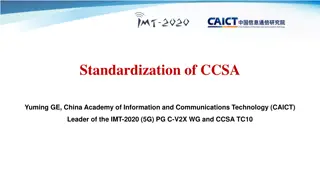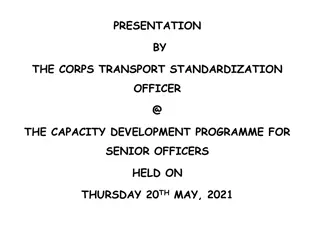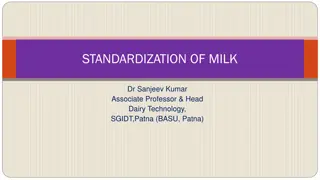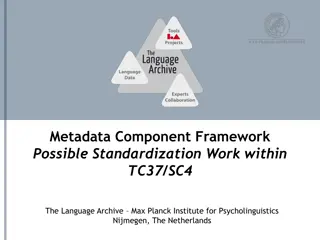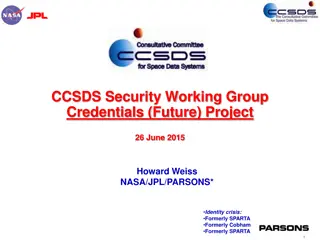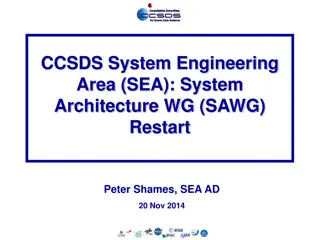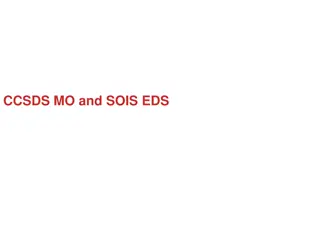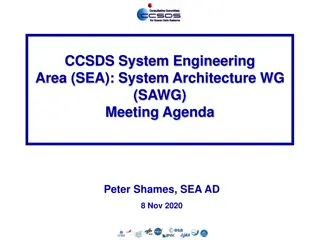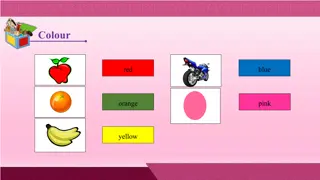Understanding CCSDS Book Colors and Contents for Effective Standardization
CCSDS uses a color-coded system for its books, such as Blue for standards, Magenta for recommended practices, and Yellow for procedures. Consistency in following these guidelines is crucial for aligning protocols and avoiding breakage within the CCSDS protocol stack.
Download Presentation

Please find below an Image/Link to download the presentation.
The content on the website is provided AS IS for your information and personal use only. It may not be sold, licensed, or shared on other websites without obtaining consent from the author. Download presentation by click this link. If you encounter any issues during the download, it is possible that the publisher has removed the file from their server.
E N D
Presentation Transcript
CCSDS Boot Camp: CCSDS Book Colors and Contents Blue/Magenta/Orange/Green/Red/Pink/Yellow: what does it all mean? Peter Shames, SEA AD DoC/NIST, Washington, DC, USA April 2024 Apr 2024 SEA/PS-1
Agenda Short history of CCSDS document types and requirements Extracts from the Bible , Organization and Processes for the Consultative Committee for Space Data Systems. Yellow Book. Issue 4, Jan 2016. Current definitions of document types Requirements for finalizing standards Describe some examples that fit the guidelines Blue standards Magenta recommended practices Green descriptions And some examples that do not fit the current guidelines Apr 2024 SEA/PS-2
Why Consistency? A foolish* consistency is the hobgoblin of little minds Self Reliance, Ralph Waldo Emerson * Is consistency foolish? Is it small minded to be consistent? Apr 2024 SEA/PS-3
Why consistency is important to CCSDS One view of the CCSDS protocol stack. Example from Overview of Space Communication Protocols (OSCP), CCSDS 130.0-G-3 Only covers a part of the CCSDS stack of protocols (no MOIMS, SOIS, nor CSS) Understanding how all of these align, and how to evolve while avoiding breakage , is an important function of the Working Groups and the CESG. Apr 2024 SEA/PS-4
A Little History CCSDS used to just have three basic book colors Blue Standards: reserved for normative, directly implementable, testable, interoperability or cross support specifications. Green - Rationale & description Yellow - Reports and CCSDS Procedures Also had Red Book drafts and Pink Sheet or Book revisions After the 2003 re-organization CCSDS created some new book types, with new colors Magenta - Recommended Practice, new standards track for normative, but not directly implementable nor testable, recommendations for architectures, APIs, and procedures. Orange - Experimental, non-standards track to permit formal documentation of single (or multi-) agency experimental standards Silver Retired specifications The requirements and procedures were updated in the revised Organization and Processes for the Consultative Committee for Space Data Systems . CCSDS A02.1-Y-4, Yellow Book. Issue 4 corrigendum 2. Jan 2016 Apr 2024 SEA/PS-5
CCSDS Procedures Manual CCSDS A02.1-Y-4, dated Jan 2016 The CCSDS Organization and Processes (Procedures) Manual is a Yellow Book that provides specific guidance to CMC, CESG, Areas and WGs: Defines specific organization roles and responsibilities Defines book colors , content, and norms Defines criteria for labeling any given book Defines interoperability testing criteria Clarifies handling of reference architectures, application profiles, processes, and application programming interfaces as Magenta Defines necessary terminology Requires compliance across all working groups Empowers ADs, WG chairs, and Secretariat technical editor to identify mis-assigned documents during any part of the review cycle Most recent changes: Inclusion of updates to the SANA Procedures and the Registry Management Policy Revised and extended definitions of consensus process for use by all CCSDS organizational elements Apr 2024 SEA/PS-6
Changes to CCSDS Organization and Processes CCSDS ORGANIZATION AND PROCESSES document had a major update, April 2014 The latest revisions addressed some issues that arose during CCSDS document development & review: CCSDS Architecture Principles ISO Patent policies, RAND licensing, WG requirements, WG member conduct Revision of the Blue Book and Magenta Book categories - Remove the category of Application Profile Magenta Book - Add 2 new categories of Blue Books: Utilization Profile and Adaptation Profile. - Clarify the distinctions between Blue Books and Magenta Books - Provide a clear definition for "protocol Define operations of the SANA and the role and structure of the SANA Steering Group (SSG). Membership rules for participants in CCSDS WG meetings have been clarified, SIG and BoF both defined CCSDS Code of Conduct requirements, included in CWE login & meeting attendance Procedure definition for conditional approval closures Charter & WG approval procedure clarifications Clarification of CCSDS Tech Editor submission and periodic review procedures Add requirements, structure, and contents for the Protocol Implementation Conformance Statement (PICS) Pro Forma Creation of new CCSDS IMPLEMENTATION CONFORMANCE STATEMENTS, CCSDS A20.1-Y-1 guideline Recommendation that required test plans use the (P)ICS Pro Forma Apr 2024 SEA/PS-7
A note about CCSDS operating procedures Working Groups are where the detailed technical work of CCSDS is done. CCSDS is an international consensus standards organization Consensus does not necessarily mean that unanimous agreement has been reached, but that the result incorporates the best set of compromises that all parties can agree to. Generally speaking, when a group votes using majority rule or parliamentary procedure, an adversarial dynamic is created within the group because it is being asked to choose between two (or more) competing possibilities. The consensus process, on the other hand, creates a cooperative dynamic. The Area Director (AD) must approve all draft documents from the WG before they are forwarded to the CESG for review and approval. Working Groups must demonstrate that consensus processes were followed when drafting documents. The entire CESG must review each CCSDS document prior to its entering a track, and CESG consensus is required before that document can move forward. After CESG approval, which may require iteration with the WG, documents are forwarded to the CMC who vote to authorize release for agency review. See Sec 2.3.2 for CESG Operating guidance, Sec 2.3.3 for Working Group guidance, and Sec 5 for tools, charters, and approval processes, and the conduct of various meetings Apr 2024 SEA/PS-8
CCSDS Standards Tracks CCSDS Document Development Stages Working Group Development Internal Configuration Control Processing and Secretariat CCSDS guidance, procedures, minutes, test plans, etc. Apr 2024 SEA/PS-9
Why you should care about colors ? CCSDS has defined different book categories for a reason Different technical contents Different purposes Different styles (and templates ) Different approval procedures & criteria Because of these real distinctions it is usually not possible to just paint a book a different color Not OK to downgrade a book because of personal or agency preferences about what is an acceptable standard It is up to the agencies to determine whether they will adopt a CCSDS recommendation as an agency standard, but that is a separate issue from the content of the book Producing books with incorrect or inappropriate content or format just makes more work for everyone, WG, tech editor, CESG, and agencies Apr 2024 SEA/PS-10
Book Type Definitions (1 of 5) From the revised Organization and Processes for the Consultative Committee for Space Data Systems . CCSDS A02.1-Y-4, Yellow Book. Issue 4. Jan 2016. RECOMMENDED STANDARDS (BLUE BOOK) CCSDS Recommended Standards (Blue Books) define specific interfaces, technical capabilities, or protocols, or provide prescriptive and/or normative definitions of interfaces, protocols, or other controlling standards such as encoding approaches. Recommended Standards must be complete, unambiguous and at a sufficient level of technical detail that they can be directly implemented and used for space-mission interoperability and cross support. Recommended Standards must say very clearly, These are the technical properties of what the implementer must build and how it must behave if it is to be compliant and interoperable. Blue Books may be of three different types: 1) CCSDS Recommended Standard (a document that internally contains a native specification developed by CCSDS); 2) CCSDS Recommended Standard: Adaptation Profile (a document that adopts/adapts a native specification developed somewhere else, such as by another standards organization); 3) CCSDS Recommended Standard: Utilization Profile (a document that specifies how to use one or more existing CCSDS Blue Books or other normative standards to perform a particular function). Blue Books defining communications protocols must include a Protocol Implementation Conformance Statement (PICS) proforma as a normative annex. Apr 2024 SEA/PS-11
Book Type Definitions (2 of 5) RECOMMENDED PRACTICES (MAGENTA BOOK) CCSDS Recommended Practices (Magenta Books) are the consensus results of CCSDS community deliberations and provide a way to capture best or state-of- the-art approaches for applying or using standards or for documenting reference architectures and other formal specifications. Magenta Books may document guidelines for standardized processes or procedures for accomplishing tasks. They may document reference models or reference architectures to assist in the design, use, description, or selection of one or more standards. Practices say, Here is how the community recommends that one should carry out or describe this particular kind of operation at present, or how the community recommends that it should be carried out in the future. While these guidelines are generally different in scope and style from protocol standards, their establishment needs a similar process [to that used for Blue Books] for consensus building. Apr 2024 SEA/PS-12
Book Type Definitions (3 of 5) RECOMMENDED PRACTICES, contd Recommended Practices are normative and have prescriptive content but are typically not directly implementable for interoperability or cross support. They may be of several types: a) specifications that are foundational for other specifications, but within themselves do not define content in a way that allows independent development and testing of separate but interoperable systems; b) system descriptions that are more general in nature and capture best or state-of- the-art recommendations for applying standards or defining standardized processes; c) reference architectures and other formal but not directly implementable specifications; d) operational practices that are associated with other CCSDS specifications. e) Application Programming Interfaces (API), which are useful for portability but do not in themselves provide interoperability. Apr 2024 SEA/PS-13
Book Type Definitions (4 of 5) CCSDS EXPERIMENTAL (ORANGE BOOK) The experimental designation typically denotes a specification that is part of some research or development effort. Its funding and other associated resources are normally independently provided by the organization that initiates the work, and so the CCSDS role is limited to one of periodic review of the work and approval for publication. Experimental work may be based on soft or prospective requirements; i.e., it may be looking into the future and may intend to demonstrate technical feasibility in anticipation of a hard requirement that has not yet emerged. This designation therefore allows the work to progress roughly to the equivalent technical status of a Draft Recommended Standard without being actually on the Normative Track and therefore consuming large amounts of CCSDS resources. Experimental work may be rapidly transferred onto the Normative Track if a hard requirement emerges, thus shortening the response time in satisfying the new customer. Apr 2024 SEA/PS-14
Book Type Definitions (5 of 5) CCSDS INFORMATIONAL (GREEN BOOK) The informational document designation is intended to provide for the timely publication of a very broad range of general information for the CCSDS community. Informational documents are often published in support of an experimental specification, a Draft Recommended Standard, or a Recommended Standard. They may therefore contain overview or descriptive material, supporting analysis, requirements, descriptions of use, scenarios, etc., which are otherwise inappropriate for the contents of a normative technical specification. CCSDS ADMINISTRATIVE TRACK (YELLOW BOOK) The Administrative Track includes all CCSDS administrative documents such as CCSDS charters, procedures, processes, and meeting minutes. They are given the designation of CCSDS Record (Yellow Book). Yellow Books shall be used to document the test plans and test reports produced in support of CCSDS Blue Book and Orange Book interoperability testing. Yellow Books may also be used to document CCSDS internal processes, procedures, and controlling guidelines. This document [CCSDS A02.1-Y-4] is itself a CCSDS Yellow Book, and it is a controlling document describing CCSDS procedures. Any CCSDS Yellow Book that is normative upon CCSDS itself requires CESG review and CMC approval. Apr 2024 SEA/PS-15
Finalizing a Recommendation 3.2.1.c Blue Book Requirements Converting a CCSDS Draft Recommended Standard to a CCSDS Recommended Standard always is preceded by a successful final, formal agency review. With a few exceptions (for which waivers must be sought), conversion of a Draft Recommended Standard to a Recommended Standard also requires that at least two independent and interoperable prototypes or implementations must have been developed and demonstrated in an operationally relevant environment, either real or simulated. In cases in which one or more options or features have not been demonstrated in at least two independently developed interoperable prototypes or implementations, the specification may advance to the CCSDS Recommended Standard level only if those options or features are removed. The Yellow Book documenting qualifying implementations and validation testing must include specific statements, preferably in the form of a filled out PICS proforma (when present), about the implementations ability to support each of the individual options and features. For any document on track to become a Recommended Standard, the WG shall develop an Interoperability Test Plan based on the document s Implementation Conformance Statement (ICS) proforma. If patented or otherwise controlled technology is required for the implementation, it must be demonstrated that the licensing process and fees are reasonable and non-discriminatory. Apr 2024 SEA/PS-16
Finalizing a Recommendation, contd 2.3.3 A NOTE CONCERNING REFERENCE IMPLEMENTATIONS The standardization procedures that have been defined greatly increase the significance and value of producing prototypes and implementations as requirements to progress along the document track. It is recognized that implementing a major complicated standard may be a significant piece of work and therefore developing reference implementations that can be shared is highly desirable. Making reference implementations available to prospective designers of operational systems can offer them cost- and risk-reduction advantages and can help in the testing of their fielded implementations. Apr 2024 SEA/PS-17
Orange Book vs Blue Book Orange Book Needs well understood requirements, may be one Agency Must be formatted as a Blue Book Must have one prototype and a test jig to demonstrate interoperability Needs WG & AD consensus to publish Requires CESG/PID resolution if issues are raised Requires CESG concurrence & CMC approval for publication Blue Book Needs solid requirements, and two (or more) Agencies Must be formatted as a Blue Book Must have two prototypes that demonstrate interoperability Needs WG & AD consensus to send to Agency review Requires CESG review and concurrence, & CMC approval, for Agency Review Requires CESG/PID resolution if issues are raised Requires one (or more) Agency review Requires RID resolution at each stage Needs WG & AD consensus to publish Requires CESG concurrence & CMC approval for publication This can be a faster path to publish a needed experimental specification 18 SEA/PS-18
Typical Blue Book Examples Prox-1 Protocol, Data Link Layer, CCSDS 211.0-B-4 Layered model protocol architecture, PDUs, data link layer, timing and data services, operations, and I/O sub-layer Normative PDU data structures, transfer frames, and field definitions, formal control and data transport and behavior specifications, state table specifications of protocol behavior, abstract required service spec for I/O sub-layer SLE Forward CLTU Service Specification, CCSDS 912.1-B-2 Description, architectural model, service operations, protocol, data types, conformance matrix Structure diagrams, state diagrams, formal operations, parameters, & English and state chart behavioral descriptions, formal ASN.1 PDU, data type, interface & parameter specifications, IP Over CCSDS Space Links, CCSDS 702.1-B-1 Overview, PDU formats, service primitives and protocol layer mappings Concrete protocol layers (multiple), multiplexing & mappings, formal protocol identifiers, concrete PDU mappings and multi-layer adaptations, abstract provided service specification XML Specification for Navigation Data Messages. CCSDS 505.0-B-1 Normative description of XML based message structure, elements, keywords, data types, for state vectors, segments, metadata XML specification, schema references, namespace Apr 2024 SEA/PS-19
Typical Magenta Book Examples SLE API for Transfer Services, Core Specification, CCSDS 914.0- M-1 SLE API specification, architecture, requirements, structure, components, and behavior UML model of architecture, components, interfaces & behavior, structured English mapping to formal SLE specs, state tables in UML & OCL, normative interfaces defined in C++, normative error codes Reference Architecture for Space Data Systems (RASDS), CCSDS 311.0-M-1 Viewpoints, views, stakeholders, concerns, representations, relationships relevant for CCSDS ISO RM-ODP derived models, ISO 42010 & UML derived viewpoints, representations, and terminology Space Communications Cross Support Architecture Requirements Document, CCSDS 901.1-M-1 An encyclopedic document that describes how sixty CCSDS (and other) standards may be used to build interoperable systems. Uses the RASDS architecture methodology and viewpoints Apr 2024 SEA/PS-20
Typical Green Book Examples Prox-1, Rationale, Architecture & Scenarios, CCSDS 210.0-G-1 Overview, abstract architecture, abstract operations and scenarios Abstract layered architecture, operational behavior, sequence diagrams, and state machines, graphical application scenarios and usage diagrams SLE Cross Support Concept Part 1: Space Link Extension Services, CCSDS 910.3-G-3 Background, environment, abstract descriptions of architecture, functional components, operations, data transfer services, service management, applicability Formal and informal diagrams, deployed systems, interactions, PDUs, state machines, tables of attributes and data types Navigation Data, Definitions And Conventions, CCSDS 500.0-G-3 Overview, message exchange framework, ancillary data, properties, measurements, applicability Process, terms, abstract message exchange and data types, English & mathematical descriptions of frames of reference, time scales, properties, maneuvers, and observational techniques TM Synchronization and Channel Coding--Summary of Concept and Rationale, CCSDS 130.1-G-2 Overview of telemetry systems, application of coding and synchronization methods, scholarly treatment of technical details and performance of different approaches, rationale for choosing one method over another. Layered architecture, performance curves, relationship of coding & synch to other layers in stack, descriptions of coding algorithms Apr 2024 SEA/PS-21
Comparative Message Layer Example SM&C Message Header From CCSDS 521.0-R-2 Field name, value, (no length) Defined as non-normative - NOTE The structures used in the body of the examples for each pattern are only examples and as such no explanation of contained values or meanings is provided or required. - NOTE An actual service specification, rather than the example given here, would fully specify the meaning of, and required values of, all structures used by the service. AMS Message Header From CCSDS 735.1-R-0.1 Field, name, length, values Defined as normative - Each AMS message shall consist of a header in fixed format followed by zero or more octets of content. - The AMS message header shall consist of the fields shown in table 5-4. The PDU header fields shall be transmitted in the order of presentation in table 5-4. Apr 2024 SEA/PS-22
Comparative Service Example SM&C Core Action Service Operations From CCSDS 522.0-R-1 Field name, order, contents, (no field sizes) Not really normative - Data definitions in MAL are abstract - No protocol or behavior definition SLE CLTU PDU From CCSDS 912.1-B-2 Field name, order, contents, sizes Normative - Messages are defined unambiguously in ASN.1 - Data definitions are unambiguous - Protocol and behavior is defined in state tables Apr 2024 SEA/PS-23
Comparative Data Definition Example SM&C Data Definitions From CCSDS 521.0-R-2 Attribute name and abstract type Not normative - Does not fix data types in an unambiguous way - Does not define field sizes - Does not define aggregate object representations SLE Data Definitions From CCSDS 912.1-B-2 Field name, size, order, contents Normative - Data type is defined unambiguously in ASN.1 - Field sizes and data definitions are unambiguous - Exact composite structure & representation is provided Apr 2024 SEA/PS-24
SANA Process Changes The Space Assigned Numbers Authority (SANA) supports the operations of CCSDS by providing an efficient way to define dynamic (or static) registries for CCSDS standards objects Each Blue or Magenta Book is required to include a SANA Considerations section, as described in Annex B, Space Assigned Numbers Authority (SANA) Role, Responsibilities, Policies, and Procedures, CCSDS 313.0-Y-3, Oct 2020 SANA Registries must be created and tested before publication of the document. Start before Red Book submission. The current revision of the SANA Procedures introduced a new Registry Management Policy (RMP), CCSDS 313.1-Y-2, which defines a set of re-usable and extensible organization, person, and object identifier registries. The RMP has a companion document, Procedures for SANA Registry Specification, CCSDS 313.2-Y-2, that defines Working Group guidelines for using and creating compliant registries. Spacecraft ID registry procedure, CCSDS 320.0-M-7, was changed to allocate SCIDs on a per frequency bin basis. Defines a Qualified-SCID (Q-SCID). Apr 2024 SEA/PS-25
SANA Registries CCSDS SANA Registries Enterprise Registries Global Registries Local / WG Registries Organization Registry ISO OID Registry Protocol Registries URN Registry WG ID Registries Member Agency XML Registry WG Catalogs Observer Agency Glossary WG Source Registry Affiliate Delegated ISO OID sub-tree Other ... Contact Registry HoD / PoC AR Other positions Spacecraft Registry Service Site & Aperture Registry RF Asset Registry (IOAG) Apr 2024 SEA/PS-26
SANA Steering Group: Registries SANA Steering Group (SSG) Provides guidance to the SANA operator Technical review body for registry changes and issues Contact: ssg@mailman.ccsds.org Space Assigned Numbers Authority (SANA) and related policies (http://sanaregistry.org) The CCSDS Organization & Processes, CCSDS A02.1-Y-4, Sec 2.3.1.4.7, established the SANA, the SANA Operator, and the SSG The Space Assigned Numbers Authority (SANA) Role, Responsibilities, Policies, and Procedures, CCSDS 313.0-Y-1, defines the SANA, SSG, and WG roles and procedures. - Sec 3.8 defines the requirement that very CCSDS standards track document (Blue or Magenta) must include a SANA Considerations section. - Sec 3.10 says all new protocol registries required by CCSDS documents shall be created as part of SANA operations. A new registry shall be created by the SANA operator based on a CCSDS-approved document where the instructions to create the registry and the registration rules to add new registrations are documented. - Sec 3.10 says The SANA operator shall notify the CESG and the related WG chairs when a new registry is ready for a preliminary or final review. It is the responsibility of the working group to test and validate the registry according to the rules that it established in the registry creation document. - Annex B provides an outline and expected contents for the SANA Considerations section The Procedures for SANA Registry Specification, CCSDS 313.2-Y-2, define what is expected of a WG that requires a new or modified registry, including an overview of the existing Enterprise, Global, and Local registry structures and guidelines for what is expected of each WG. - Sec 2.3 describes the overall WG flow, including e) Develop an initial registry design prior to initial Red Book finalization and describe it in the draft SANA Considerations section. Work with the SANA Operator to create the candidate registry prior to the start of interoperability testing, and exercise the registry during testing. - Sec 3.2.1 has a concise description of the process steps that each WG needing to define a registry is intended to follow. - Sec 3.3 says The CESG shall verify that any new or modified registry has been created and tested prior to standard publication. The Registry Management Policy, CCSDS 313.1-Y-2, is the full set of SANA registry policies and also the details of the design for the Enterprise and Global registries. - Sec 2.8 says Before a new registry is proposed, or before changes to an existing registry are made, a WG must review the existing SANA registries to determine if re-use or extension of existing capabilities would be satisfactory. - Annex B contains examples of abstract registry designs and relationships as well as concrete registry table designs. Apr 2024 SEA/PS-27
CCSDS Quality & Governance CCSDS has a history of producing quality documents of a number of different types There has been remarkable consistency across this growing suite of documents Users have a well justified expectation that CCSDS standards can be directly implemented and that they will interoperate; demonstration of interoperability is required for publication The reputation that CCSDS has built rests on the solid implementability of our Blue Books. The CCSDS leadership is adamant that Blue Books must continue to be implementable. Recent additions of document types have caused some confusion and lines have become blurred The addition of new WGs and technical areas of work, and new WG chairs, document authors, and participants who do not have the CCSDS historical perspective, presents challenges The ultimate issue is the "quality of the CCSDS standards product" and whether any given document that has been produced meets the relevant tests There is an open question as to whether all of CCSDS has to be about interoperability and cross support or if other "intra- operability or portability standards are acceptable. The updated CCSDS Procedures document presents a clear set of guidelines and criteria to guide current and new working groups Apr 2024 SEA/PS-28
Consensus Definition Changes from A02.1-Y-4C1 2.3.3.2 Working Group Operating Procedures The principle of consensus applies to all of the operations at the WG level. Working Groups must demonstrate that consensus processes were followed when drafting documents. (See 5.1.2 for a discussion of consensus.) 5.1.2 Consensus The decisions of all CCSDS organizational units shall be reached through consensus. In this context, consensus does not necessarily mean that unanimous agreement has been reached, but that the result incorporates the best set of compromises to which all parties can agree. Generally speaking, when a group votes using majority rule or parliamentary procedure, an adversarial dynamic is created within the group because it is being asked to choose between two (or more) competing possibilities. The consensus process, on the other hand, creates a cooperative dynamic. Issues are identified, and the chairperson or facilitator outlines candidate solutions in the form of neutral proposals. During discussion of a proposal, everyone works to improve the proposal to make its adoption or rejection the best-achievable decision to which the whole group can agree. Interim voting may be used to judge the degree to which the group is converging on consensus, but the final outcome must reflect a true consensus result. An individual is responsible for expressing concerns; the group is responsible for resolving them. The group decides whether a concern is legitimate; the individual decides whether to concur with the group, block, or stand aside. All significant issues and their disposition must be documented and accepted by the group. See Annex G for a set of Consensus Guidelines that should be used to guide the execution of the consensus process in all CCSDS organizations. Apr 2024 SEA/PS-29
Some Definitions Interoperability: The technical capability of two or more systems or components to communicate, exchange information, and to use the information that has been exchanged Cross Support: An agreement between two or more organizations to exploit the technical capability of interoperability for mutual advantage, such as one organization offering support services to another in order to enhance or enable some aspect of a space mission Protocol protocol: A set of rules and formats (semantic and syntactic) which determines the communication behavior of (N)-layer protocol entities in the performance of (N)-layer protocol functions. A protocol is a convention or standard that controls or enables the connection, communication, and data transfer between two computing endpoints. In its simplest form, a protocol can be defined as the rules governing the syntax, semantics, and synchronization of communication. Apr 2024 SEA/PS-30
References Organization and Processes for the Consultative Committee for Space Data Systems. CCSDS A02.1-Y-4, Yellow Book. Issue 4, Corrigendum 2. Jan 2016. CCSDS Publications Manual. CCSDS A20.0-Y-4, Yellow Book. Issue 4, Corrigendum 1. Feb 2015. CCSDS Implementation Conformance Statements, CCSDS A20.1-Y-1, Yellow Book, Issue 1, April 2014. Space Assigned Numbers Authority (SANA) Role, Responsibilities, Policies, and Procedures, CCSDS 313.0-Y-3, Issue 3, Oct 2020. CCSDS Registry Management Policy, CCSDS 313.1-Y-2, Issue 2, Oct 2020. Procedures for SANA Registry Specification, CCSDS 313.2-Y-2, Issue 2, Oct 2020. Apr 2024 SEA/PS-31
BACKUP SLIDES Apr 2024 SEA/PS-32
Other Considerations Reference Models & Architectures These are distinguished in some contexts (OASIS, OMG), and there are real differences, but there is no need for CCSDS to emphasize these distinctions Treat all of this class of documents as Magenta Books APIs APIs, in and of themselves, do not provide interoperability but are useful for application portability The SLE model for developing and labeling of APIs seems appropriate and this maps into Magenta Book specifications Portability specifications Other specifications, such as the JMS, or similar shims provide portability These do not meet CCSDS (nor Internet or ECSS) requirements for standards, but do offer useful functionality Include specifications of this sort as Magenta Books CCSDS procedures We currently have a number of CCSDS procedures that are Yellow Books and we may need a few more Some Procedures Yellow Books are normative on the CCSDS processes and practices, this use is to be documented Apr 2024 SEA/PS-33
Mis-assigned Book Examples SLE Cross Support Reference Model, CCSDS 910.4-B-1 (grandfathered, now Blue, really Magenta, not directly implementable) Environment, abstract descriptions of architecture, interfaces, services, and use in systems SLE derived representations & definitions, including Abstract Service Definition Conventions (ASDC) from 910.2-G-1 Information Architecture Reference Model, CCSDS 312.0-G-1 (now Green, really Magenta, reference model) Information and system architecture, abstract software components and interfaces, applicability to space data systems Layered abstract architecture, UML structural and data models, abstract component interfaces Reference Model for an Open Archival Information System (OAIS), CCSDS 650.0-B-1 (grandfathered, now Blue, really Magenta, reference model & processes) Abstract reference model, concepts, responsibilities, abstract process & functional models, preservation, archive interoperability, defined terminology English process descriptions, abstract data & data flow models, abstract functional & layered models, abstract UML structure and package diagrams Apr 2024 SEA/PS-34
Standardization Norms (1 of 3) CCSDS Blue Book Norms There are separate concrete specs for each layer from physical to link (and upper layer as well) Each spec stands alone, can be interpreted and evaluated on its own, and unambiguously defines the standard service at that layer and what functions it must perform Each spec defines the services it provides to an upper layer and the services it expects from a lower layer, usually abstractly Each spec defines a wire protocol, with concrete PDUs and state machine (in some unambiguous form), but does not specify either a language binding nor any sort of API, these are implementation details that need not be bound in order to support interoperability While each spec stands alone you need to select a compatible stack of them on each end (physical, modulation, coding, link, ...) in order to deliver end to end (link layer) data, but how you implement them (C, Java, hardware. software) at each end of the link need not be defined Apr 2024 SEA/PS-35
Standardization Norms (2 of 3) Internet Norms There are separate concrete specs for each layer from link to network / transport, including service management Each spec stands alone, can be interpreted and evaluated on its own, and unambiguously defines the standard service at that layer and what functions it must perform Each spec defines the services it provides to an upper layer and the services it expects from a lower layer, usually abstractly Each spec defines a wire protocol, with concrete PDUs and state machine (in some unambiguous form), but does not specify either a language binding nor any sort of API, these are implementation details that need not be bound in order to support interoperability While each spec stands alone you need to select a compatible stack of them on each end (link, network, transport, routing exchange, ...) in order to deliver end to end (transport layer) data, but how you implement them (C, Java, hardware. software) at each end of the link need not be defined Apr 2024 SEA/PS-36
Standardization Norms (3 of 3) Other Interoperability Standards USB & Firewire - Define hardware interfaces, functionality, behavior & wire protocols - Work on Mac, PC, Linux, etc, cameras, thumb drives, disk drives, TV decoders, etc, evolve w/ backward compatibility X-windows - Defined user interface, API, functionality, behavior & wire protocols - Works on Mac, PC, Linux, etc, provided very useful interoperability & portability Counter-Examples JAVA Messaging Service (JMS) - API, functionality, behavior, no wire protocol - Application portability but no interoperability from different vendors, has required vendor bridges to be developed OMG CORBA specifications - Concrete IDL, interfaces, functional behavior of framework, no wire protocol - Application portability but no interoperability across different vendors until IIOP and GIOP were defined (later), required much re-work of vendor implementations Service Oriented Architecture (SOA) - A paradigm and a reference model, not yet a set of standards - A SOA can only be built today by using vendor specific products and it will only be after standard components, interfaces, protocols, and interaction patterns are defined that there will be anything like a SOA standard . Ref IAWG & IPRWG Apr 2024 SEA/PS-37
Contrast / Compare SM&C SM&C approach There are separate abstract specs for each layer from message bus, core, common, mission operations applications (not yet defined) Each spec can be interpreted and analyzed on its own, and abstractly defines the standard service at that layer and what functions it must perform - The SM&C WG asserts that you must interpret them as a whole, but this is not necessary Each spec defines the services it provides to an upper layer and the services it expects from a lower layer, with some specificity Each spec defines an abstract protocol with abstract PDUs and rudimentary state machine, but does not specify either a concrete protocol nor concrete PDUs. There is only a concrete binding and wire protocol defined after there is a concrete implementation binding to a language and technology, which must be defined in separate documents at each layer How you implement them (C, Java, protocols, PDUs, etc) at each end of the link must be defined according to a single concrete binding. While each spec stands alone you need to implement the complete stack of them on each end (message bus, core, common, mission operations applications, ...) in order to deliver end to end (application layer) data In order to interoperate each element in the stack at each end must be implemented using the same concrete bindings, language, and technology or they must use the same underlying shared implementations Source: Analysis of SM&C MAL, Core, Common CCSDS 521.0-R-2, 522.0.R-1, 521.1-R-1 Apr 2024 SEA/PS-38
